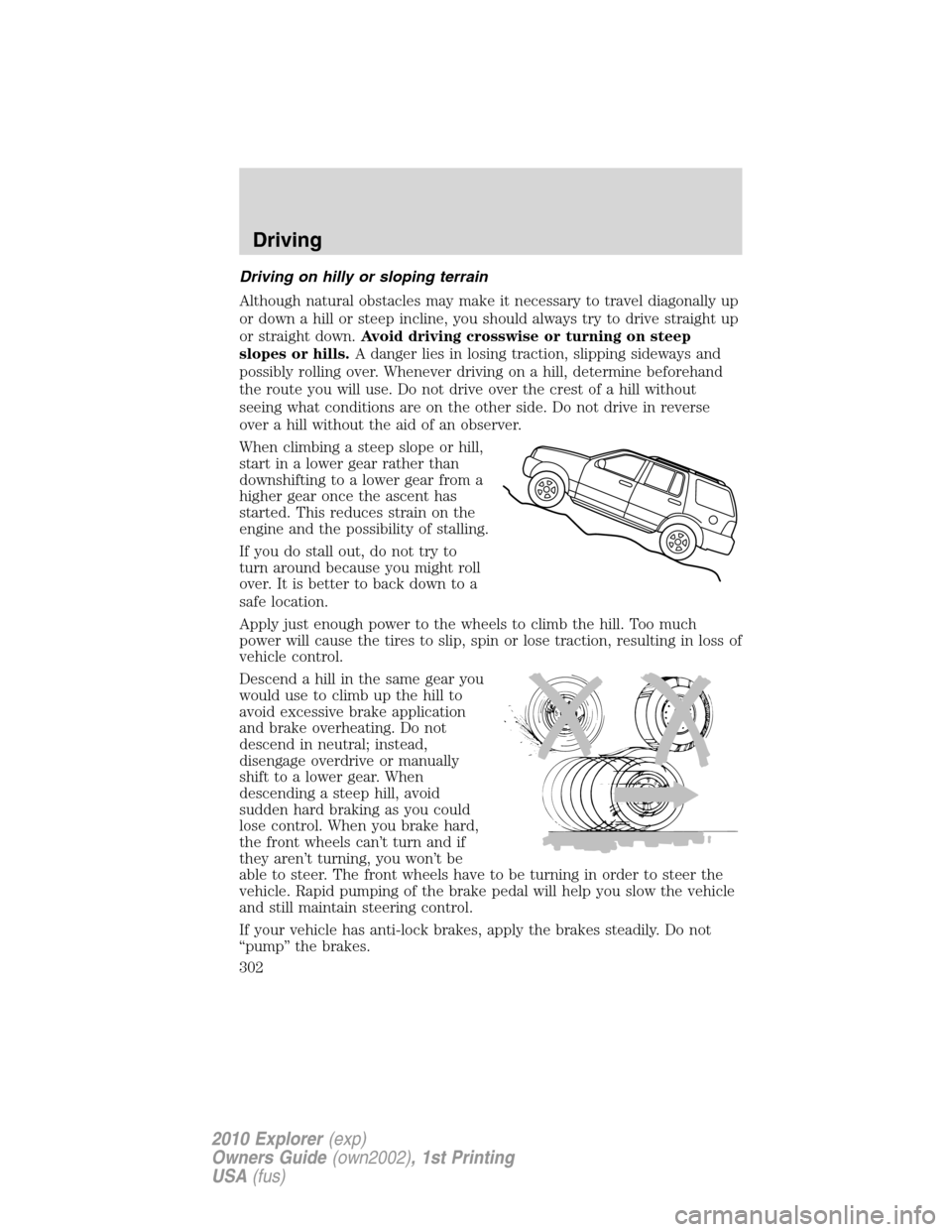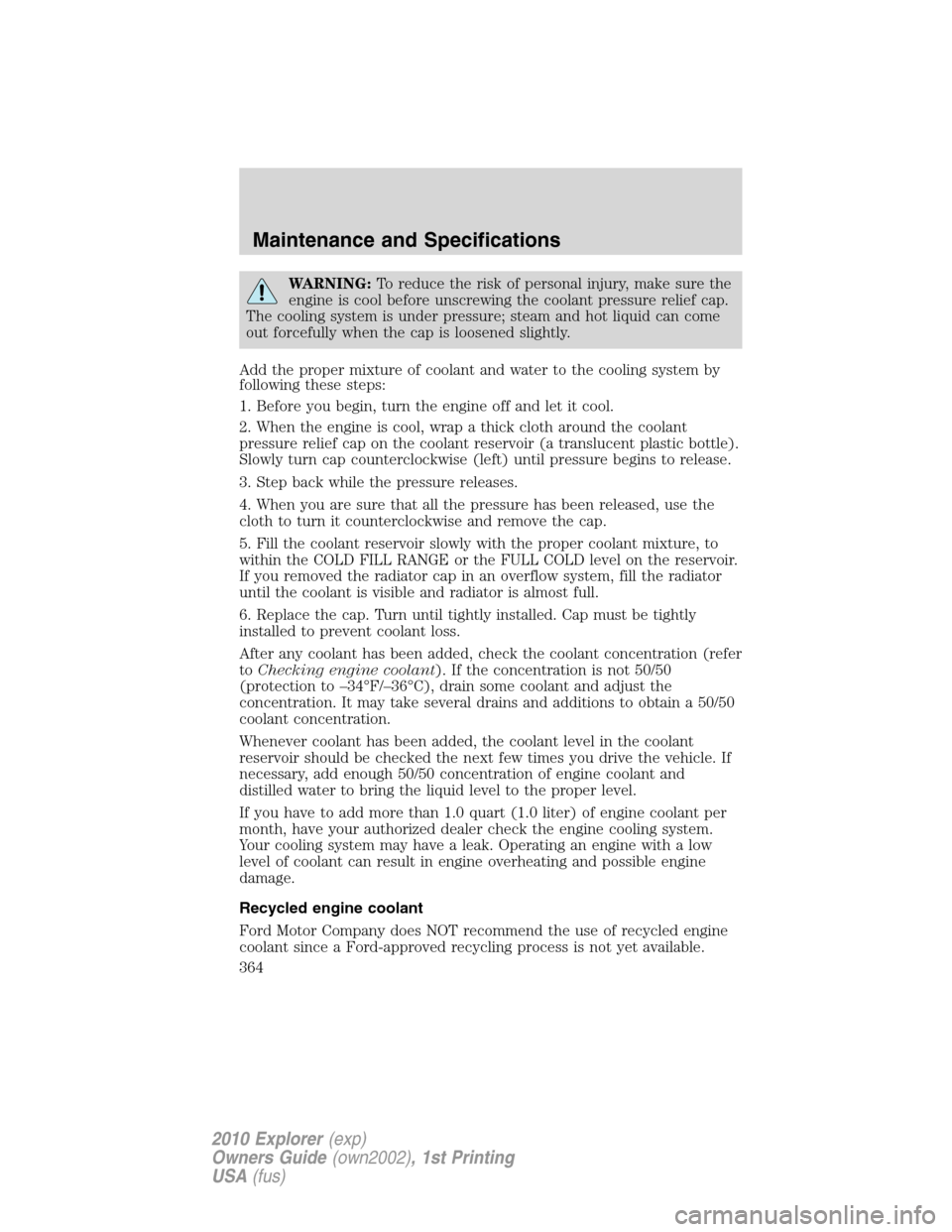2010 FORD EXPLORER AC heating
[x] Cancel search: AC heatingPage 302 of 404

Driving on hilly or sloping terrain
Although natural obstacles may make it necessary to travel diagonally up
or down a hill or steep incline, you should always try to drive straight up
or straight down.Avoid driving crosswise or turning on steep
slopes or hills.A danger lies in losing traction, slipping sideways and
possibly rolling over. Whenever driving on a hill, determine beforehand
the route you will use. Do not drive over the crest of a hill without
seeing what conditions are on the other side. Do not drive in reverse
over a hill without the aid of an observer.
When climbing a steep slope or hill,
start in a lower gear rather than
downshifting to a lower gear from a
higher gear once the ascent has
started. This reduces strain on the
engine and the possibility of stalling.
If you do stall out, do not try to
turn around because you might roll
over. It is better to back down to a
safe location.
Apply just enough power to the wheels to climb the hill. Too much
power will cause the tires to slip, spin or lose traction, resulting in loss of
vehicle control.
Descend a hill in the same gear you
would use to climb up the hill to
avoid excessive brake application
and brake overheating. Do not
descend in neutral; instead,
disengage overdrive or manually
shift to a lower gear. When
descending a steep hill, avoid
sudden hard braking as you could
lose control. When you brake hard,
the front wheels can’t turn and if
they aren’t turning, you won’t be
able to steer. The front wheels have to be turning in order to steer the
vehicle. Rapid pumping of the brake pedal will help you slow the vehicle
and still maintain steering control.
If your vehicle has anti-lock brakes, apply the brakes steadily. Do not
“pump” the brakes.
Driving
302
2010 Explorer(exp)
Owners Guide(own2002), 1st Printing
USA(fus)
Page 363 of 404

Adding engine coolant
When adding coolant, make sure it is a 50/50 mixture of engine coolant
and distilled water. Add the mixture to the coolant reservoir,when the
engine is cool,until the appropriate fill level is obtained.
WARNING:Do not add engine coolant when the engine is hot.
Steam and scalding liquids released from a hot cooling system
can burn you badly. Also, you can be burned if you spill coolant on hot
engine parts.
WARNING:Do not put engine coolant in the windshield washer
fluid container. If sprayed on the windshield, engine coolant
could make it difficult to see through the windshield.
•Do not mix coolants. Add the coolant type originally equipped
in your vehicle.Refer toMaintenance product specifications and
capacitiesin this chapter.
Note:Do not use stop leak pellets or cooling system sealants/additives
as they can cause damage to the engine cooling and/or heating systems.
This damage would not be covered under your vehicle’s warranty.
•A large amount of water without engine coolant may be added, in case
of emergency, to reach a vehicle service location. In this instance, the
cooling system must be drained and refilled with a 50/50 mixture of
engine coolant and distilled water as soon as possible. Water alone
(without engine coolant) can cause engine damage from corrosion,
overheating or freezing.
•Do not use alcohol, methanol, brine or any engine coolants
mixed with alcohol or methanol antifreeze (coolant).Alcohol
and other liquids can cause engine damage from overheating or
freezing.
•Do not add extra inhibitors or additives to the coolant.These
can be harmful and compromise the corrosion protection of the engine
coolant.
For vehicles with overflow coolant systems with a non-pressurized cap
on the coolant recovery system, add coolant to the coolant recovery
reservoir when the engine is cool. Add the proper mixture of coolant and
water to the FULL COLD level. For all other vehicles which have a
coolant degas system with a pressurized cap, or if it is necessary to
remove the coolant pressure relief cap on the radiator of a vehicle with
an overflow system, follow these steps to add engine coolant.
Maintenance and Specifications
363
2010 Explorer(exp)
Owners Guide(own2002), 1st Printing
USA(fus)
Page 364 of 404

WARNING:To reduce the risk of personal injury, make sure the
engine is cool before unscrewing the coolant pressure relief cap.
The cooling system is under pressure; steam and hot liquid can come
out forcefully when the cap is loosened slightly.
Add the proper mixture of coolant and water to the cooling system by
following these steps:
1. Before you begin, turn the engine off and let it cool.
2. When the engine is cool, wrap a thick cloth around the coolant
pressure relief cap on the coolant reservoir (a translucent plastic bottle).
Slowly turn cap counterclockwise (left) until pressure begins to release.
3. Step back while the pressure releases.
4. When you are sure that all the pressure has been released, use the
cloth to turn it counterclockwise and remove the cap.
5. Fill the coolant reservoir slowly with the proper coolant mixture, to
within the COLD FILL RANGE or the FULL COLD level on the reservoir.
If you removed the radiator cap in an overflow system, fill the radiator
until the coolant is visible and radiator is almost full.
6. Replace the cap. Turn until tightly installed. Cap must be tightly
installed to prevent coolant loss.
After any coolant has been added, check the coolant concentration (refer
toChecking engine coolant). If the concentration is not 50/50
(protection to –34°F/–36°C), drain some coolant and adjust the
concentration. It may take several drains and additions to obtain a 50/50
coolant concentration.
Whenever coolant has been added, the coolant level in the coolant
reservoir should be checked the next few times you drive the vehicle. If
necessary, add enough 50/50 concentration of engine coolant and
distilled water to bring the liquid level to the proper level.
If you have to add more than 1.0 quart (1.0 liter) of engine coolant per
month, have your authorized dealer check the engine cooling system.
Your cooling system may have a leak. Operating an engine with a low
level of coolant can result in engine overheating and possible engine
damage.
Recycled engine coolant
Ford Motor Company does NOT recommend the use of recycled engine
coolant since a Ford-approved recycling process is not yet available.
Maintenance and Specifications
364
2010 Explorer(exp)
Owners Guide(own2002), 1st Printing
USA(fus)
Page 399 of 404

Child safety seats - booster
seats ...........................................229
Cleaning your vehicle
engine compartment ..............342
instrument panel ....................344
interior .....................................345
plastic parts ............................343
washing ....................................340
waxing .....................................341
wheels ......................................341
wiper blades ............................343
Climate control (see Air
conditioning or Heating) ..........101
Clock adjust
6-CD in dash .............................52
AM/FM/CD .................................45
Compass, electronic
calibration .................................27
set zone adjustment ...........27, 36
Console ..............................120–121
overhead ..................................119
rear ..........................................121
Controls
power seat ...............................170
steering column ......................130
Coolant
checking and adding ..............361
refill capacities ................365, 385
specifications ..........................385
Cruise control
(see Speed control) ..................128
Customer Assistance ................305
Ford Extended Service
Plan ..........................................395
Getting assistance outside the
U.S. and Canada .....................337
Getting roadside assistance ...305
Getting the service you
need .........................................333Ordering additional owner’s
literature .................................338
Utilizing the
Mediation/Arbitration
Program ...................................337
D
Daytime running lamps
(see Lamps) ..............................107
Defrost
rear window ............................105
Dipstick
automatic transmission
fluid ..........................................380
engine oil .................................354
Driveline universal joint and
slip yoke ....................................382
Driving under special
conditions ..................291, 298, 302
sand .........................................300
snow and ice ...........................303
through water .................301, 304
Dual automatic temperature
control (DATC) .........................101
DVD system .................................66
E
Electronic message center ...21, 30
Emergencies, roadside
jump-starting ..........................325
running out of fuel .........325, 372
Emergency Flashers .................306
Emission control system ..........377
Engine ........................................390
cleaning ...................................342
coolant .....................................361
fail-safe cooling .......................366
Index
399
2010 Explorer(exp)
Owners Guide(own2002), 1st Printing
USA(fus)
Page 400 of 404

idle speed control ...................359
lubrication specifications .......385
refill capacities ........................385
service points ..................350–351
starting after a collision .........307
Engine block heater .................274
Engine oil ..................................354
checking and adding ..............354
dipstick ....................................354
filter, specifications ........357, 384
recommendations ...................357
refill capacities ........................385
specifications ..........................385
Event data recording ....................7
Exhaust fumes ..........................273
F
Fail safe cooling ........................366
Family entertainment system ....66
Fluid capacities .........................385
Fog lamps ..................................107
Four-Wheel Drive vehicles .......294
driving off road .......................296
indicator light .........................294
preparing to drive your
vehicle .....................................284
Fuel ............................................367
calculating fuel
economy ......................27, 32, 374
cap ...........................................370
capacity ...................................385
choosing the right fuel ...........371
comparisons with EPA fuel
economy estimates .................377
detergent in fuel .....................372
filler funnel .............................372
filling your vehicle with
fuel ...........................367, 370, 374filter, specifications ........367, 384
fuel pump shut-off switch .....307
improving fuel economy ........374
octane rating ...................371, 390
quality ......................................372
running out of fuel .........325, 372
safety information relating to
automotive fuels .....................367
Fuses ..................................308–309
G
Garage door opener ..........120, 133
Gas cap (see Fuel cap) ............370
Gas mileage
(see Fuel economy) .................374
Gauges .........................................18
GAWR (Gross Axle Weight
Rating)
calculating ...............................262
GVWR (Gross Vehicle Weight
Rating)
calculating ...............................262
H
Hazard flashers .........................306
Headlamps .................................106
aiming ......................................108
bulb specifications ..................112
daytime running lights ...........107
flash to pass ............................108
high beam ...............................107
turning on and off ..................106
Heating
heating and air conditioning
system ...............................99, 101
Homelink wireless control
system ........................................134
Index
400
2010 Explorer(exp)
Owners Guide(own2002), 1st Printing
USA(fus)